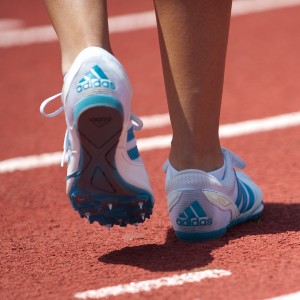For all of you uncultured masses who are just learning about track and field, we are here with a brief guide that will help you become sophisticated participants and spectators of the greatest sport ever!
The Events
There are 16 events in a standard California high school track meet. Some invitational meets will run some other non-standard events (mostly these are unusual relay combinations, such as the Distance Medley (DMR), Sprint Medley (SMR), or the 4×800 relay). There are two relay events—4×100 and 4×400. These relays start and end track meets, so the relay races are an opportunity to set the tone of the day for the team, and can be the race to determine team winners in close meets. There are six flat, individual running events: 100, 200, 400, 800, 1600, 3200. 100 through 400 are considered sprints, 1600 and 3200 are considered middle distance, and track nerd argue about whether the 800 is the longest sprint or the shortest distance race (I’m in the longest sprint camp!). There are two hurdle races – 300 intermediate hurdles for everyone, and 110 high hurdles for boys (65 for frosh-soph boys) and 100 hurdles for girls. The six field events include throws (shot put, discus); horizontal jumps (long jump, triple jump); and vertical jumps (high jump and pole vault, although Monta Vista does not compete in the pole vault).
Schedule
The CIF (California Interscholastic Federation) sets an order of events for the California State Meet, which the CCS (Central Coast Section, our section) follows for the CCS championship meet. These big meets have fairly set time schedules. The SCVAL (Santa Clara Valley Athletic League, our league) follows the same order so we get used to running events in the same schedule. However, in league meets, while the ORDER is the same, the TIMING may be different; the goal is to try to get the meet done as efficiently as possible, so as soon as one event is complete, the next event is lined up and fired off. In some events, the boys and girls may be combined in different ways to save time (for example, in a dual meet, typically all the boys and girls will run the 3200 at the same time; the Varsity and frosh-soph boys may run the 1600 at the same time; horizontal jumps may be run ‘open pit’ with everyone getting their jumps in at the same time; etc.). So you need to pay attention to the flow of the meet, and check with the starter or meet director to see if your event is being run in a certain way.
Also, while field events have a preferred order, league/dual meets may be a little more informal. Usually while the girls are throwing the discus, the boys are throwing the shot, and then they switch. Same with the long and triple jumps, though in some dual meets the meet director might run everything together. Again, in dual meets, if you are not sure when you are going to compete in your field event, find the official right at the start of the meet and check with them.
On the track, the order of events in a dual meet or a CIF meet is:
4 x 100
1600
100M (g) /110 (b) hurdles
400
100
800
300 hurdles
200
3200
4 x 400
This will always be the schedule. Know the schedule, know when your event happens, do not ask the coaches when you are going to run. You should be able to get in the habit of keeping track of what is going on, so you will learn when to start warming up—for example, if you are competing in the 3200, you will start to figure out that when the 800 finishes you want to start jogging, when the JV girls heat starts for the 200 you want to be on your final strides—whatever works for you, you have a plan.
Invitational meets (or ‘invites’) will vary in their schedule, so you need to find a meet program and figure out for each meet when you need to be warmed up, when you need to report, etc.—and pay attention to how fast events before you are proceeding.
Scoring
SCVAL dual meets are scored 5 points for first place, 3 for 2nd, and 1 point for 3rd in each event for each division (Varsity boys and girls, JV girls and frosh-soph boys). The only exceptions are the relay events, which are scored 5 for first place and zero—the big goose egg—for second. High total score for all events wins.
Big meet scoring will vary. For example, in the CCS championship meet, scoring is for the top eight places as follows: 10, 8, 6, 5, 4, 3, 2, 1.
### Etiquette and Courtesy ###
Find out where you are expected to warm up. In some meets you can warm up on the infield (inside the track); at some meets there are outside areas provided and the meet organizers want you off the infield. Once the meet starts you should not warm up on the track itself. Please follow the rules.
Carefully listen to the starter’s instructions (even if you have heard this many times before).
A couple of very important items:
- Competitive Courtesy: Please say good luck to at least one of your competitors before the race, and say good race to at least one competitor after the race—no matter how happy or sad you are feeling! It’s good karma, if nothing else, and it always will reflect well on you, your family and your school.
- Officials and Volunteers: It takes a lot of effort by many people to pull off a track meet. Without the help of coaches, officials and volunteers, we would not have track meets. Every athlete should say ‘thank you for being here’ to at least one volunteer, official, or teacher at every meet. Your comments really matter! It’s guaranteed, the better reputation that MV Track & Field has, the better meets we have, the more likely we are to get volunteers, the more likely we are to get help when we need it or are cut some slack when we make a mistake, and the more fun we will have. So make it a goal—thank at least one volunteer or official at every meet you participate in!
- Help Out! Always look for opportunities to grab a hurdle and help set up, or anything else where you can be useful.
- Cheer! Support your teammates while you are not running. Head over to the jump pits or the throwing rings and see what your teammates are doing.


